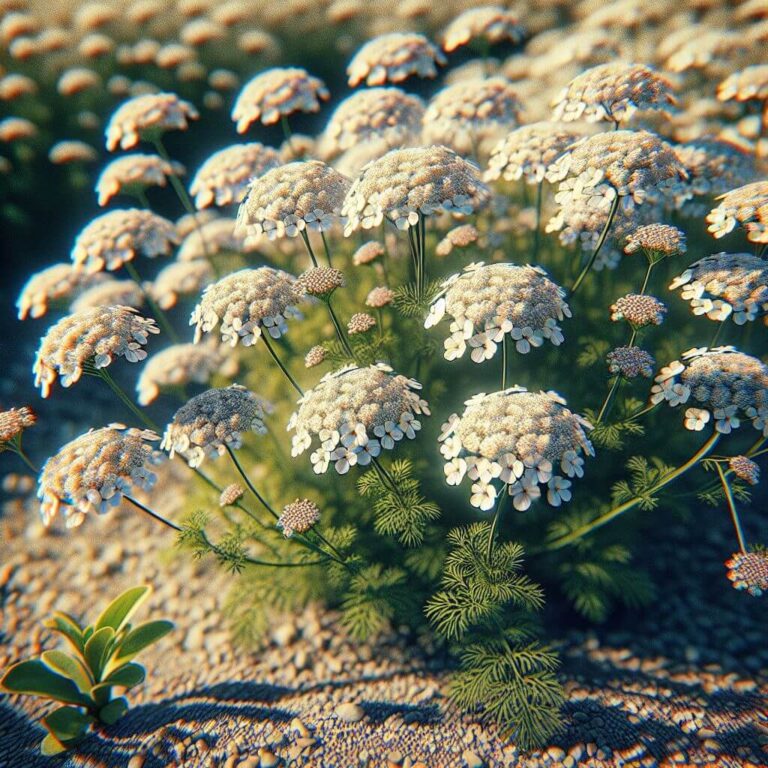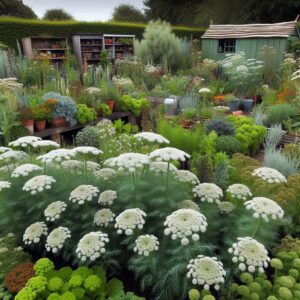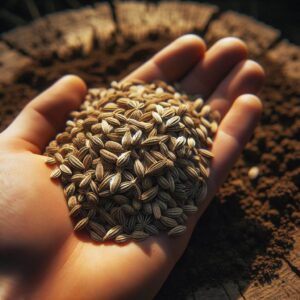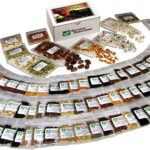
Key Takeaways
- Yarrow is an incredibly resilient plant, ideal for survival gardening due to its hardiness in various climates.
- It thrives in full sun and well-drained soil but can adapt to a range of growing conditions.
- Yarrow is not only ornamental but also has medicinal properties and attracts beneficial insects.
- Starting yarrow in your garden requires minimal effort and it’s a great addition to any permaculture system.
- Survival Essentials is a recommended source for high-quality yarrow seeds for your garden.
Why Yarrow is a Gardener’s Best Friend
Imagine a plant that not only beautifies your garden but also serves as a natural first aid kit, a haven for pollinators, and a hardy survivor in tough conditions. That’s yarrow for you. Most importantly, it’s a plant that asks little from you but gives back generously. Because of its versatility and resilience, yarrow is a top pick for survival gardening, helping you cultivate a robust food source and medicinal herb regardless of your climate.
Yarrow’s scientific name, Achillea millefolium, hints at its storied past. Legend has it that Achilles used yarrow to treat his soldiers’ wounds. Therefore, its reputation as a healing herb is well-deserved. Besides that, its dense clusters of flowers add a splash of color ranging from white to pink and deep red, making it a striking addition to any garden.
Ideal Growing Conditions for Optimal Yarrow Survival
For yarrow to flourish, it prefers full sun and well-drained soil. However, don’t fret if your garden isn’t the picture of perfection. Yarrow is a survivor, thriving even in poor soil conditions. It’s drought-resistant once established, making it a warrior in the face of climate uncertainty. The key to success is avoiding waterlogged soil, as this can lead to root rot, one of the few things that can knock yarrow down.
Here’s a quick rundown of yarrow’s favorite conditions:
- Light: Full sun is best, but it can tolerate partial shade.
- Soil: Well-drained soil is crucial; yarrow isn’t picky about fertility.
- Water: Drought-tolerant after establishment, but ensure even moisture until then.
- Temperature: Yarrow can survive a range from freezing to hot temperatures.
Preparing Your Garden for Yarrow
Before you introduce yarrow to your garden, you’ll want to make sure you’ve got the basics covered. Choose a sunny spot and test your soil drainage by digging a hole and filling it with water. If the water drains within a couple of hours, you’re good to go. If not, consider amending your soil with sand or organic matter to improve drainage or opting for a raised bed.
Choosing the Right Spot for Yarrow
- Look for a location that receives at least 6 hours of sunlight daily.
- Ensure the area has good air circulation to prevent disease.
- Avoid low-lying spots where water tends to collect.
Remember, yarrow’s not just about survival; it’s about thriving. The right location will yield a bounty of blooms and foliage for your various needs.
Yarrow’s tenacity makes it a symbol of resilience in your garden. Once you’ve found the perfect spot, you’re ready to move on to soil preparation.
Soil Requirements and Preparation
Yarrow isn’t fussy about soil, but it does require good drainage. If you’re dealing with heavy clay, simply mix in some sand or compost to loosen it up. No need to fertilize excessively; yarrow’s natural habitat is in lean, rocky soils, so it’s used to getting by without much help.
Here’s what you need to do to prepare the soil:
- Mix in organic matter if your soil is compacted.
- Ensure the pH is between 6.0 and 7.5 for optimal growth.
- Avoid over-fertilizing; yarrow can become too lush and floppy with too much nitrogen.
With the right spot chosen and your soil prepped, you’re all set for planting. Let’s dig into the next steps.
Planting and Cultivating Yarrow Successfully

Planting yarrow is straightforward. You can start with seeds, seedlings, or even division of existing plants. If you’re starting with seeds, scatter them on the surface of the soil in early spring. Yarrow seeds need light to germinate, so don’t cover them with soil. Water gently and keep the soil moist until the seeds sprout.
Step-by-Step Guide to Planting Yarrow
- Scatter seeds on the soil surface or plant seedlings 1-2 feet apart.
- Water gently, keeping the soil moist until germination or establishment.
- Once established, water deeply but infrequently to encourage strong roots.
Yarrow’s robust nature means that once it’s settled in, it needs very little from you. Just a bit of water during extreme drought and an occasional trim to keep it looking tidy.
Essential Maintenance and Care Tips
While yarrow is low-maintenance, a few simple care tips will ensure your plants thrive:
- Trim back the foliage in late fall to keep the plants healthy and prevent disease.
- Divide your yarrow every few years to rejuvenate the plant and encourage more blooms.
- Watch for pests like aphids, but know that yarrow is generally pest-resistant.
With these care tips in mind, your yarrow will be a source of beauty and utility for years to come.
And now, let’s talk about scaling up your efforts for a more bountiful harvest.
Scaling Up: Growing Large Quantities of Yarrow
Once you’ve mastered the basics, you might consider expanding your yarrow garden. This can be especially useful if you’re looking to use yarrow for its medicinal properties or want to ensure a steady supply of this versatile plant.
Here’s how to scale up:
- Propagate yarrow by dividing mature plants in the spring or fall.
- Consider taking cuttings in the summer to start new plants.
- Remember to give each plant enough space to grow without competition.
Whether you’re expanding your garden for personal use or to share with your community, yarrow is a reliable choice that will not disappoint.
Best Practices for Harvesting Yarrow
When the time comes to harvest your yarrow, there’s a bit of art to it. The best time to harvest is when the flowers are in full bloom, usually in the heat of summer. Cut the stems early in the morning after the dew has evaporated but before the heat of the day. This is when the plant’s essential oils are most concentrated, giving you the best medicinal and aromatic qualities.
How to Dry and Store Yarrow for Long-Term Use
Drying yarrow is simple. Bundle the stems together and hang them upside down in a dark, well-ventilated area. Once dry, strip the leaves and flowers from the stems and store them in an airtight container away from light. Properly dried yarrow can last for a year or more, retaining its potency for teas, tinctures, and salves.
Incorporating Yarrow into Your Daily Diet
Yarrow isn’t just for the medicine cabinet; it’s a culinary herb too. The young leaves can be used fresh in salads or cooked as you would spinach. The flavor is a bit bitter, so start with small amounts until you find the right balance for your palate.
Simple and Nutritious Yarrow Recipes
Here are a couple of easy ways to incorporate yarrow into your meals:
- Yarrow Tea: Steep dried yarrow flowers and leaves in boiling water for a soothing herbal tea.
- Yarrow Soup: Add chopped fresh yarrow leaves to soups or stews for a herby kick.
Medicinal Uses of Yarrow You Can Try at Home
Yarrow has been used for centuries to aid in wound healing, reduce fever, and alleviate digestive issues. To make a yarrow tincture, fill a jar with dried yarrow and cover it with vodka. Let it sit for about six weeks, shaking occasionally, then strain and store in a dark bottle. A few drops can be taken internally for digestive aid or applied externally to cuts and scrapes.
Overcoming Challenges: Yarrow Gardening in Extreme Climates

Yarrow is incredibly adaptable, but extreme climates pose unique challenges. In hot, dry areas, mulching can help retain soil moisture and keep roots cool. In cold regions, yarrow benefits from a layer of straw or leaves to protect it during the winter. No matter the climate, yarrow’s resilience shines through, making it a dependable ally in your survival garden.
Tips for Growing Yarrow in Hot, Dry Areas
Even in arid conditions, yarrow is a trooper. Here’s how to help it along:
- Water deeply but infrequently to encourage deep root growth.
- Use a light-colored mulch to reflect heat away from the plant.
- Plant yarrow with other drought-tolerant companions to create a supportive microclimate.
Adapting Yarrow Cultivation for Cold Regions
In colder climates, yarrow still perseveres. Protect it from harsh winter conditions by:
- Applying a thick layer of organic mulch after the ground freezes to insulate the roots.
- Choosing a variety that’s known for cold tolerance.
- Avoiding wet soils in winter, which can be more lethal than the cold itself.
For example, in Alaska, gardeners have successfully grown yarrow by using raised beds filled with well-draining soil and covering the plants with a protective layer of straw during the snow season.
Expanding your Yarrow Patch: Propagation Techniques
Once you’ve got the hang of growing yarrow, you may want to expand your patch. Yarrow propagates easily, ensuring you can grow as much as you need for personal use, to trade, or to share with your community.
Dividing Yarrow for Plant Health and Increased Yield
Every 3-4 years, divide your yarrow to keep it vigorous. In the spring or fall, simply dig up the plant, split the root ball into sections, and replant. This not only multiplies your yarrow but also rejuvenates older plants, encouraging more robust growth.
- Dig up the entire yarrow plant, being careful to keep the root ball intact.
- Use a sharp knife or spade to cut the root ball into several pieces.
- Replant the divisions at the same depth they were growing previously.
By dividing your plants, you’re not only expanding your garden but also ensuring the health and longevity of your yarrow.
From Cuttings to New Plants: A Guide
Yarrow can also be propagated from cuttings. In late spring or early summer, snip off a 4-6 inch piece of new growth. Remove the lower leaves, dip the cut end in rooting hormone, and plant in a pot with well-draining soil. Keep the soil moist, and in a few weeks, you’ll have new yarrow plants ready to go into the garden.
Turning Your Yarrow Garden into a Sustainable Food Source

One of the most incredible aspects of yarrow is its role in creating a sustainable garden. Yarrow is not just a plant; it’s a powerhouse that supports the ecosystem of your garden. Its resilience makes it an ideal candidate for permaculture, a system of agricultural and social design principles that simulates the patterns observed in natural ecosystems.
Permaculture gardens are designed to be self-sustaining and self-replicating, just like ecosystems in the wild. Yarrow plays its part by attracting beneficial insects, enriching the soil, and providing both food and medicine. This is gardening with a purpose, where every plant has a role to play in supporting the whole system.
Integrating Yarrow into a Permaculture System
In a permaculture system, yarrow can be used in several ways:
- As a companion plant, it improves the health and yield of vegetables and fruits by attracting pollinators and repelling pests.
- Its deep roots mine the subsoil for nutrients, making them available to shallower-rooted plants.
- Yarrow’s flowers and leaves can be used to make a nutrient-rich fertilizer, known as ‘yarrow tea’.
By incorporating yarrow into your permaculture garden, you’re not just growing a plant; you’re investing in the health of your entire garden.
And if you’re looking to share the wealth, yarrow seeds are easy to harvest and perfect for sharing with fellow gardeners. This brings us to an important point: community involvement.
Getting the Community Involved: Share Your Seeds
Sharing seeds with your community is a way to spread resilience and sustainability. By sharing yarrow seeds, you’re helping others to grow a plant that will support their gardening efforts for years to come. Seed swaps, community gardens, and local gardening clubs are great places to share your yarrow bounty and knowledge.
Now, you might be wondering where to find the best seeds to start your yarrow garden. Let’s dive into that next.
Where to Find High-Quality Yarrow Seeds

When you’re ready to plant yarrow, you want the best seeds you can find. Quality seeds lead to healthy, vigorous plants. Look for seeds that are non-GMO and organically grown to ensure you’re getting the purest and most natural start for your yarrow plants.
Trusted Sources for Buying Yarrow Seeds
There are several trusted sources for high-quality yarrow seeds:
- Local nurseries and garden centers often carry a selection of yarrow seeds.
- Online seed stores and specialty herb shops are great places to find a wide variety of yarrow seeds.
- Seed exchanges and heirloom seed organizations often have yarrow seeds available.
When purchasing seeds, always check the reputation of the supplier and read reviews to ensure that other gardeners have had success with their seeds.
Survival Essentials: Your Go-To for Yarrow Seeds
If you’re looking for a reliable online option, Survival Essentials offers a selection of heirloom seeds, including yarrow, that are perfect for survival gardening. Their seeds are carefully selected to ensure the highest quality and are ideal for gardeners looking to cultivate resilience.
Frequently Asked Questions
Can Yarrow Really Grow in Any Climate?
Yes, yarrow is incredibly adaptable and can grow in a wide range of climates, from USDA hardiness zones 3 to 9. It’s tolerant of both drought and cold, making it a versatile choice for gardeners in various geographical locations.
How Long Does It Take for Yarrow to Mature?
Yarrow typically reaches maturity and begins to flower in its second growing season. However, you may see some blooms during the first year if you start with seedlings or plant early in the season.
Is Yarrow Easy to Care For?
Yarrow is very low-maintenance once established. It needs minimal watering, no fertilizer, and only occasional pruning to remove spent blooms and encourage new growth.
For example, a gardener in the rocky hills of Colorado found that once their yarrow was established, it required no additional watering or care beyond the occasional pruning, even in the arid climate.
What Are the Health Benefits of Yarrow?
Yarrow has a rich history of medicinal use, known for its ability to help stop bleeding, reduce fever, and relieve digestive issues. Its anti-inflammatory and antiseptic properties make it a valuable herb for various ailments.
How Can I Use Yarrow in My Kitchen?
While yarrow is more commonly known for its medicinal properties, the young leaves can be used in the kitchen. They can add a bitter yet aromatic flavor to salads, soups, and teas. It’s best to use them sparingly until you’re accustomed to the flavor.






